• The meaning of relief:
Introduction:
The belief of the General Directorate of civil in the great duty that ita is honored to do which is to serve the injured and to supplement the growing role in aiding the needy, we are issuing this summary news on first aid: to be in a series of jihad, which the Directorate does in the service of the citizen and resident.
Many people do not know how to act in emergency situations. Therefore, they are in a state of confusion followed by a state of fear due to the lack of knowledge, but through the right training you can learn how to overcome it and how to seek help in a correct way and provide the appropriate care that save lives. The relief system is designed to raise the chances of survival by providing immediate and appropriate care in the field and during a transport trip to the hospital.
• First Aid:
it is providing appropriate medical care of life-sustaining of the victim until the ambulance team arrived.
• The foundations of first aid:
Designed to raise the chances of survival ‘if Allah wills’ through providing immediate attention to the accident scene and during transporting to hospital.
It is divided into four sections:
1) Survey the scene: to ensure the absence of what might threaten your safety and the safety of injured.
2) the first examination: to identify and address life-threatening injuries as follows:
Check to see if the injured was:
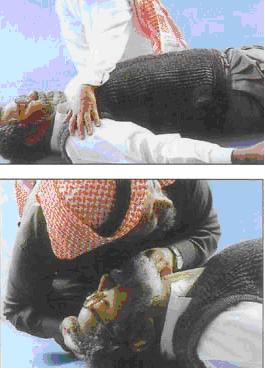
A. Conscious: by shaking his shoulders and talking to him.
B. The airway is opened ‘the nose and mouth’ and cleaning it of the remains, and the airway is opened by tilting the head back with the forward lifting of the chin.
C. Breathing: use your three senses sight, sense, and hearing and to make sure of that.
1) Look at the raise and lowering of the chest.
2) Hear the voice of entry and exit of air from the nose and mouth.
3) Feel the air stream coming outside of the mouth by using your Backhanded or cheek.
4) If the victim is not breathing: make a respirator save (kiss of life).
D. Beat: sense the pulse in the neck: - feel Adam's apple then move your finger to the depth found near it and try to feel the pulse.
In the absence of a pulse CPR must be carried out.
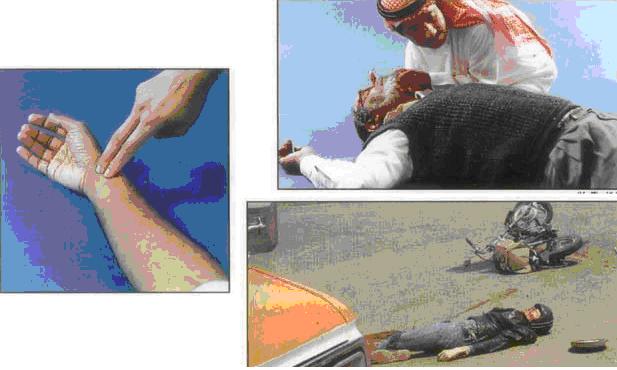
2) Call the ambulance group.
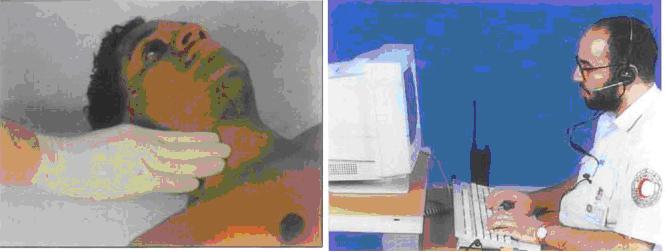
3) Secondary examination:
To identify and address other casualties in the absence of a life-threatening injuries. And the secondary examination includes examining the injured from his head to the toes
• Ventilator rescuer (kiss of life):
Is a way for the passage of air into the lungs of the injured. And then to the body. Ventilator is given when the injured stops breathing.
How to give ventilator rescuer:
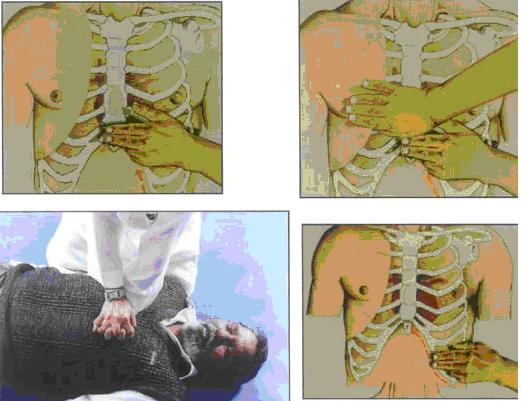
1) Open the airway way by tilting the head and lifting the chin.
2) Set the mask in order to surround the mouth and the nose, or by putting the mouth to the victim’s directly after setting up a roadblock at the mouth of gauze and blow through it.
3) Give the injured two breathings slowly: to see the chest rise then stop just after each breath to let the air come out.
4) check the pulse of the injured, after that:
5) If he has a pulse but still not breathing, apply ventilator to give the injured the same every five seconds to one minute, then re-examine the pulse to ensure its continuance, and continue with the artificial breathing with checking the pulse every minute, and do not stop only if the injured started spontaneous breathing.
• Usefulness of air exhale:
the gases depend in the movement from one place to another on the pressure difference between the two places, for it always move from a place of a higher pressure to place of a lower pressure, and that the concentration of oxygen in the air exhaled is 16-18%, therefore, when it is used to save the injured who stopped breathing, it will act according to the law Shown, so that we can save them by using this simple method.
• Infections transmission:
We can give artificial breathing from the mouth to mouth directly without the use of the mask provided under a condition that you should know that the patient did not suffer any of the diseases that can be transmitted by saliva or blood disease, HIV (AIDS), except that caution must be taken by using a pocket mask with a valve to save any injured, or by setting a barrier of cloth or gauze on the victim's mouth and blow through it
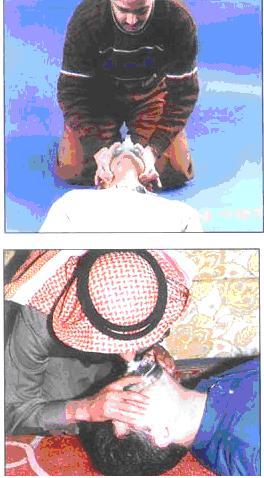
• Warning:
We can give artificial breathing from the mouth to mouth directly without the use of the mask provided under a condition that you should know that the patient did not suffer any of the diseases that can be transmitted by saliva or blood disease, HIV (AIDS), except that caution must be taken by using a pocket mask with a valve to save any injured, or by setting a barrier of cloth or gauze on the victim's mouth and blow through it.
• Ambulatory cases and dealing with it:
• Cardiac arrest:
It is when the pulse of heart fails in which it prevents the blood circulation in the body.
When the pulse of the heart stops, accordingly to this the breathing process stops too. And if these two devices stop performing it is called in this case clinical death.
• Causes of the heart attack:
Cardiovascular disease, drowning, suffocation, severe injuries, electric shock.
• Indicators of cardiac arrest:
Stop of the pulse is the basic indicator for a heart attack: However, the brain cells and vital organs such as the heart and the kidney continue living until the amount of oxygen is carried out of the body.
• First aid for a heart attack:
Hold CPR, which combines between the ventilator and the chest pushing through which it performs the function of the heart and lungs together and this continues until the arrival of advanced medical care.
• CPR:
Combines between the artificial ventilator and the chest pushing (heart massage): It performs the function of the heart and lungs together.
• Its importance:
Increase the chances of the injured to live ‘if God wills’ and that through the flow of oxygen in the blood to the brain, and without it the brain begins to die during the 4-6 minutes, and this is called the biological death.
• The proper status of the infected:
The injured must be lying on a solid and flat surface, face up, with his head at the same level of the heart.
Opens a stream of air by tilting the head back and pushing the lower jaw by the fingers upwards.
• The proper status of savior:
sit on your knees and next to the victim’s chest with your hands in the proper status.
Make almost stretch your arms in a straight line with the extension of the elbow in a way to make your shoulders to be directly over your hands.
Pressure directly to the bottom.
It is important that the victim’s chest must return to its normal position before giving pressure again, and every pressure must pressure the bone of the chest down 4-5 cm.
• Recovery method
1) Airway is opened through tilting the head back and lifting the chin up.
2) Select the bottom of the cage of the wounded and pass your index and central finger until it reaches the bone of the sternum, and then put the two fingers on this bone and put the your second arm, then set both hands over each other.
3) Use your fore hands felt to put pressure on the bone of the sternum and then move your fingers by entangling them and lifting up.
4) Make almost stretch your arms in a straight line with the extension of your elbow to be directly over your hands.
5) in each click you must pressure the rib cage down 4-5 cm and must return to normal before the starting the pressure again.
• Recovery in the presence of one medic:
The first medic does the artificial breathing.
• Relief in the presence of two medical recoveries:
1) The first medic does the artificial breathing.
2) The second medic does the chest pushing process.
3) The ratio of the chest pushes according to the breath is 2:5.
• Drowning:
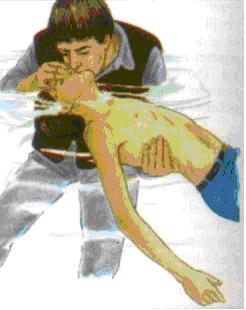
When water enters into the lungs and air passages causes the prevention of the entry of air and therefore lack of oxygen. And the drowned is in desperate need of aid because of the potential for death if the emergency care delayed to arrive.
To avoid drowning, we commit ourselves to the guidance of the beaches and swimming with a group ever.
• How to relief the drowned:
1) Withdrawal the drowned of the water in a way that the head and neck must be stabled, the turning the injured and withdrawal him; as shown in the figure.
2) If the victim is not breathing, you should be cleaning the mouth and pharynx with your fingers. You must also extend the victim's neck and start the artificial breathing from mouth to mouth
3) Sense the pulse of the carotid artery near the neck; if you did not feel it you should be carrying out the respiratory cardiac rehabilitation immediately.
4) You should not waste your time by trying to draw water from the lungs because this procedure is useless. (pressure below the diaphragm you may be cleaning the air routes in some patients, particularly those who passed through the vomiting during a cup of water.
5) Then send all the injured to hospital for observation and picturing the chest, for the pneumonia could not be cleared only in the following day.
6) You must not stop psychological support for the patients for healing may be caused.
• Snake bites:
Snake bites are abound in the desert places in the forests and remote areas of construction. And although the poisonous snakes do pose only a small proportion of the snakes, however, generally the snake bites are associated with the developing of the blood and neurological confusions which require hospitalization, and some cases end in death although of the medical care and the emergency procedures. But it may when providing the first aid at the beginning of infection to mitigate the damages caused by these stung, for often the cases that ends with death are due to the late submission of medical assistance.
The poisons of the snakes contain a number of toxic proteins; either it may cause toxic to the nerves or blood, or a dissolvent to the blood which will cause the damaging of the organs due to the bleeding led by the dissolvent of the blood.
• Symptoms of a snake bite:
1) The injured feels an acute pain in the place of the sting with a red color, swollen, and blood pumping with a taste of metal in the mouth, nausea, and tendency to vomit, and a drop in blood pressure.
2) The eyelids start to blink in addition to having a difficulty in swallowing due to muscle paralysis such as double vision or stop breathing.
• First Aid:
1) put a victim in the status of rest without moving the injured party in order to reduce the spread of Poison.
2) Put (bond compressor) a few centimeters higher from the bitten place without stretching it strongly, to prevent the return of the surface venous blood. And the bond must be freed every half hour for two minutes.
3) Do not put snow on the sting because it increases the destruction of the tissues.
4) If the injured was not transferred to hospital within 15 minutes, a split along the sting with a depth of a half centimeters and then apply the process of sucking blood long enough through the mouth or by using the breast sucker.
5) Splitting and sucking are important parts in which 50% of the injected poison under the skin will be removed if the process was done quickly.
6) Remove the victim to the hospital without moving the injured party.
• Scorpion bite:
Each of the bite of a scorpion in the desert is considered to be dangerous because it may cause a dissolvent poison to the blood or toxic to the nerve. The size and the appearance of the scorpion are not considered a measure of its risk.
The Scorpion poison causes inflammation of the heart muscle, confusion in the breathing, disorder of the kidney and nerve function and blood circulation.
• Symptoms of a scorpion bite:
1) Swelling occurs in the location of the sting.
2) Creepiness will happen in the place of the bite, abundant in saliva with a paralysis of the tongue and nerves, and this may cause severe shock with a decline in circulation.
3) A sharp pain in the place the poison was injected with formation of a spot.
4) Respiratory failure and acute kidney may occur. And death caused by the bites of scorpions caused by inadequate respiratory or heart muscle inflammation and circulation limitations.
• First Aid:
1) Put a bond to form pressure on the injured party over the place of the bite.
2) Put snow over the place of a sting.
3) Transport the injured to a specialist medical center in order to be injected with an antibiotic drug to the Scorpion.
4) If the injured was not transferred to hospital within 15 minutes, make split into 1 cm-long in the sting’s place and a half centimeters in depth and then apply the Sucking process for an appropriate time by mouth or you can use the breast sucker .
• Wounds:
The wound is a split in the skin or mucous tissue. And the injuries may be torn, according to the tool that caused the wound. This may be dangerous if injuries hit the vessel or muscle. So the expertise and knowledge of the types of injuries with first aid would reduce the damage caused by the wounds and stop bleeding.
• Types of wounds:
1) Peremptory injuries: described as bleeding injuries with the possibility of deep hit of the deep tissues (muscle and nerve and vascular).
Torn wounds: caused by road accidents and injuries of war: They can be inflamed and they need ambulatory surgery to take off the damaged tissue.
2) The surface wounds: caused by nails and staples which may be deceptive wounds, they could be very deep but did appear only as a simple split in the skin.
3) Wounds that result from road accidents: the wounds are cleaned and the remains of the alien objects are removed and sterilized gauze bandages are set.
• First aid for cuts:
1) Cleaning the wound of dirt and try to get foreign objects out from it.
2) In the bleeding wounds there must be the application of direct pressure and a gauze and cloth is put over the wound by pressing by hand.
3) Lift the injured party if the wound was in the one of the parties in order to reduce the flow of blood and thus reduce the speed of bleeding after making sure there is no break.
• Cases arising from the high temperature of the environment:
• Thermal muscle contraction: the muscle contractions occur in the arms and legs after stress. And it is a result of losing a large amount of body fluids and salt through sweat.
1) Remove the injured from the hot atmosphere and cool him by air and lukewarm.
2) Give the injured cold water and liquid through the mouth combined with a small spoon of salt per cup of water.
• Sun stroke: a result of exposure to a long period of extreme heat of the sun during the times of high air temperatures and the humidity with a low wind speed.
1) Failure occurs in the temperature control systems in the body and it fails to cool it properly, leading to a rise in the temperature over forty degrees Celsius, where there will be no ability to identify.
2) If the high temperatures continued in raising this could damage the brain cells, causing permanent disability or death.
• Symptoms:
1) The injured loses consciousness.
2) The injured will undergo a High temperature with a dry skin.
• First Aid:
1) The injured must be cooled by using the lukewarm continuously until he is taken to the hospital.
2) In the case of loss of consciousness the patient is placed in as in the awakens position (sleep on the right side with the right hand under the head of and fold his left knee and the upper left party).
• Spinal injury:
The most important causes: car accidents and fall from a high point.
Seriousness of the injury is that any error in dealing with the victims of these incidents could mean that the victim will spend the rest of his life and unable and seated. Therefore: Do not move any injured that is likely to have spinal column injury only by a specialized team and coach.
To determine the possibility of spinal injury: Ask if the victim if he was aware the following questions:
- Can you move your feet?
- Can you move the finger?
If the injured could not move his feet and his fingers: he may have a spinal column injury.
Ask the injured to hold your hand and then note the force of his grab, a strong grip means that the spinal column is not injured.
• First aid in the fractures of the spine:
1) Do not move the head or neck.
2) When a victim is lifted, his head must be surrounded by cushions to secure and prevent it from moving.
3) A portable metal is set under the victim and then he is lifted carefully.
4) To calm the injured.
• Poisoning:
Poison is the substance that if it was able to enter the body in a certain quantity, it may cause damage. And toxins can enter the body through the accidental or intended ways such as:
1) Swallowing through the digestive system.
2) Injection in muscle or blood vessels the poison of the snakes and scorpions and drugs.
3) Inhalation through the lungs, such as vehicle exhaust during the fire.
4) The poison through the digestive system,’ swallows’ is the most common between the children under five years are the most ones affected by poisoning cases.
More causes of poisoning are the chemicals used at home such as:
Liquid detergent and bleach clothes pesticides, adhesives liquid, medicines when used in wrong doses. Therefore, you must be cautious and keep the medicines away from the children.
• Symptoms: abdominal pain and a sense of vomiting and diarrhea.
The person who is undergoing the poison is relieved by following steps:
1) Maintaining the airway open.
2) Contact ambulatory services and the poisons center.
3) Try to push the patient to vomit using the Ipecac syrup Abecal defined as ‘a large spoonful of food for a glass of water‘and half of the amount recommended for children. It is preferable not to let the patient to try to vomit through putting his finger in the finger throat.
4) Vomiting s kept in a cleaned box to be submitted to the doctor as well as package of the toxic substance if it was available.
5) In case the patient is still unconscious, he must be set in the state of the awakened one.
6) In the case of respiratory or cardiac failure rehabilitation must be applied to the injured according to his condition.
• poisoning due to the injection method within the muscle or blood vessels.
A - Drug poisoning: is a result of the misuse of certain drugs, whether accidental or intentional.
Symptoms: change or loss of natural awareness, difficulty in breathing, very slow race of the pulse
the injured must be transferred quickly to the hospital and the relieved with oxygen.
B - poisoning injecting ‘snake bites and scorpion bites’:
Symptoms: excursion in vision and dizziness, nausea and vomiting, sweating, severe muscle weakness, the inability to move, severe local pain and swelling of in the place of the bite.
• First aid:
1) Make the injured rest and ask him not to move as well as try to comfort him and call an ambulance.
2) Tie over the place of injury and about 5 cm below, taking into account not to make a very powerful Tie in order not to impede the blood circulation.
3) Make the place of the bite or sting lower the level of the heart.
4) Wipe the point of injury with alcohol or water and soap.
5) Try to split or wound the place of infection and absorb the poison.
6) Cool the place of the bite to delay the absorption of poison.
C - Toxic gas inhalation or suffocation:
The most frequent especially in the burning, factories of industrial gases, and Freon gas.
1) gases are classified into:
2) Poisonous gas carbon monoxide.
3) Suffocating gas carbon dioxide.
• poisoning by gas causes:
1) Difficulty in breathing to the point of suffocation.
2) Awareness is influenced to the degree of comma
3) Nausea and vomiting.
• Aid required:
1) Removal of the injured from the gas location.
2) Give the injured the adequate amount of oxygen.
3) Check the ability of the injured to breathe alone.
4) Artificial Breathing if it is requested.
• Burns:
Three types:
1) Thermal burns.
2) Chemical burns.
3) Electrical burns.
1) Thermal burns: result from exposure to direct fire ‘flame’ or hot liquids.
Three degrees of burns:
- First-degree burns: affect the outer layer of skin.
- Characteristics: red color in the skin with a simple swollen and severe pain that he will be cured within a week without failure raised.
- Second-degree burns: Includes the whole outer layer and extends to the entire interior layer of the skin.
- Characteristics: the red color of the skin with bubbles and with the strip of the skin and liquid seepage, swelling and severe pain. Recovery takes about three weeks.
- Third-degree burns: it includes the two layers of the skin and extends into tissues under the skin.
- Characteristics: change in skin color: the skin takes the white color or cherry color, or coal color, and because there is no due to the nerve damage.
• First Aid:
1) Removal of the injured from the cause of the fire.
2) Rapid assessment for the passage of air, pulse, and external bleeding.
3) Take off from the injured the rings, bracelets, and burnt clothes without the clothes stuck to the body parts.
4) Lift the burnt organs such as hands and legs to reduce swelling.
5) Use lukewarm water continuously to cool the burned areas.
6) Do not to open any of the bubbles of the skin to prevent infection.
7) Cover the affected area sterile bandage.
2) Chemical burns:
- Caused by acid or alkaline.
- Often occur in industrial accidents or wrong use of the detergent.
• First aid:
1) Tend immediately to remove contaminated clothing and wash the burnt areas with a large amount of water at the time of the incident and continue for 20 minutes.
2) Some chemical material such as fluorine because a whole effect on the body which may lead to death, therefore, the poison center must informed immediately.
3) Electrical burns: When is the electricity supply hits the tissue, it causes high temperatures that causes in its turn deep burns of the third degree. And the electrical shock may lead to a cardiac arrest.
3) Electrical burns: When is the electricity supply hits the tissue, it causes high temperatures that causes in its turn deep burns of the third degree. And the electrical shock may lead to a cardiac arrest.
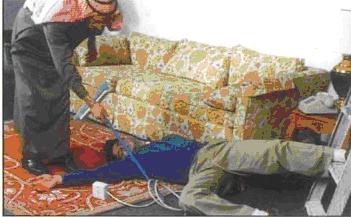
• First aid:
1) The primaries are given to the safety of the site and ensure that the electrical power is out avoid touching the injured to make sure that the power is out.
2) Assess the airway, breathing, and pulse.
3) If there is no pulse, "" heart attack "" Make CPR and continue until the arrival of advanced medical care.
4) If the pulse is present without breathing start giving the artificial respirator.
5) If the vital signs "" breathing, pulse, "" exists and stable "" Check the victim to identify the proportion of burns.
6) Burns are covered with sterile bandages.
• Bleeding:
- Is when the blood comes out of the vessels.
- The most rapid loss of 30 -40% of blood (1.5 liters -2) leads to death.
The bleeding is of two types:
- external bleeding: outside the body
- Internal bleeding: between the body tissues.
- External bleeding: 3 types:
1) Arterial bleeding: then blood comes out of the arteries, with a rapid flow and light color.
2) Venous bleeding out of the veins: a consistent flow and dark color.
3) Filamentous bleeding out of the blood vessels is not in danger.
• The ways of relief the external bleed:
1) Direct pressure on the wound: the use of sterile dressing stop most types of bleeding.
2) If the bleeding does not stop use extra pressure set by hand or put additional pressure bandages.
3) Lift the injured member: help stop the bleeding with direct pressure.
4) Pressure points: are used if the direct pressure did not stop severe bleeding from the arm or leg:
They are points where the artery is close to the surface and is near the bone where it can be squeezed. two points that can be used are one in the arm and the other in the thigh bone. And they are used in the event of the failure of direct pressure to stop the bleeding.
• Bandage:
It is used in emergency situations when other methods fail to stop the bleeding from the injured party. The bandage may cause damage to the blood vessels, and take the arm to amputation or the leg if it is left without attention for several hours. For this it is used only as a last resort to stop life-threatening bleeding, which cannot be stopped by any other means.
• Nosebleed:
is the flow of blood from the nose.
Occurs at all ages and has many reasons such as high blood pressure, and it may occur spontaneously for children.
• Types of nose bleeding:
1) Nose bleeding complacent:
Is happening in the front section of the barrier nose Coated by mucous which has the capability of bleeding to the least strain, and which is subjected to drought reasoned from the air. It is found Frequently among young people and children, and it consist 90% of the causes of bleeding.
- First aid:
To calm the injured and place him on the seat with the lifting of the head upwards.
the pressure must be on the bottom of nose
A piece of gauze drenched with iced water is set in the nostrils with the pressure for ten minutes.
2) Spontaneous nose bleeding:
- The bleeding is backwards due to the rupture of the rigid blood vessels because of the high blood pressure.
- Tend to occur in the elderly.
3) Satisfying nose bleeding:
Occurs in the context of some diseases, such as: fever, and blood diseases.
• Fractures:
Split in the bone is the result of infection.
• Types of fractures:
o Simple fractures.
o Fractures (open): is the brake in the bone with the appearance of the end of the bone causing a the wound of the skin. These fractures exposed to the outside air, and the risk of contamination considerably.
o Mixed fractures are fractures accompanied with injuries in the nerves and blood vessels surrounding tissue.
• Signs of fractures:
1) distorted in the form and the length of the injured party
2) severe pain in the place of the infection
3) swelling of the injured point
• First aid for fractures:
1) Monitoring vital signs (pulse examination and control of oxygen) and the treatment of life-threatening injuries such as the opening of a passage of the breathing and control bleeding.
2) do not move the injured party
3) Securing the injured party by a temporary splint
4) Control the bleeding in the strike zone by the use of a pressing bandage in the place of the bleeding.
